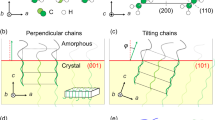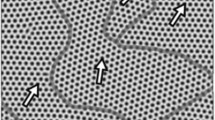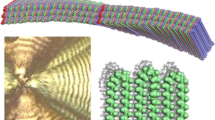Abstract
Low density polyethylene (PE) films stretched 4 x at 20° C and annealed at 100° C show the well-known SAXS four-point diagrams with a tilting angle of lamellae of 35°. The 7.5 nm thick lamellae consist of rod-like microparacrystallites (mPCs) of 25 nm x 7.2 nm lateral sizes; the long axes of the mPCs are turned around the c-axis by 31° from the b-axis. The mPCs of each lamella stack together laterally like monolayers of cigars. After rolling the molten film at room temperature and then annealing at 100° C, a doubly oriented film arises, each half of it, anterior or posterior, producing a monoclinic two-point diagram. These are superimposed in SAXS. The mPCs are oriented in the plane stress field so that their b-axis is orthorgonal to the stretching direction and parallel to the film surface; their long axes however are again turned as before, but now by 26°. Furthermore their a-axis is tilted around the b-axis by 8° and the lamellar basal surface tilted against the b-axis in the opposite direction by 40°. The line profiles of the SAXS reflections give evidence that statistical irregularities of the lamellar surfaces are correlated in the 8° tilted direction or along the chain axis with the neighbouring surfaces by means of ultrafibrillar properties of the lamellar bundles, e.g. ribbon-like microfibrillar details of the lamellae. These can be described quantitatively by applying the theory of paracrystals on the superlattice generated by the centres of the mPCs. The lamellar surfaces are approximately parallel to the {523} and {311} netplanes of mPCs for the uniaxially and doubly oriented films, respectively. The conventional theory of mesophases can never describe structures which combine lamellar and fibrillar properties.
Similar content being viewed by others
References
A. Keller and S. Sawada, Makromol. Chem. 74 (1964) 190.
J. Loboda-Čačković, H. Čačković and R. Hosemann, J. Polymer Sci. C 42 (1973) 577.
I. L. Hay and A. Keller, J. Mater. Sci. 1 (1966) 41.
Idem, ibid 2 (1967) 538.
R. Bonart and R. Hosemann, Kolloid-Z. u. Z. Polymere 186 (1962) 16.
W. Wilke, W. Vogel and R. Hosemann, ibid 237 (1970) 317.
A. Schönfeld. W. Wilke, G. Höhne and R. Hosemann, ibid 250 (1972) 102.
R. Hosemann and S. N. Bagchi, “Direct Analysis of Diffraction by Matter”, (North-Holland, Amsterdam, 1962).
W. Pechhold, S. Blasenbrey and S. Woerner, Kolloid-Z. u. Z. Polymere 189, (1963) 14.
K. Kaji, Makromol. Chem. 175 (1974) 311.
A. H. Windle, J. Mater. Sci. 10 (1975) 252.
A. Schönfeld and W. Wilke, Kolloid-Z. u. Z. Polymere 250 (1972) 496.
C. W. Bunn, Trans. Faraday Soc. 35 (1939) 482.
G. Allen, G. Gee and G. J. Wilson, Polymer 1 (1960) 456.
R. Bonart and R. Hosemann, Makromol. Chem. 39 (1960) 105.
C. Hermans, Z. Krist 79 (1931) 186.
Author information
Authors and Affiliations
Additional information
Dedicated to P. P. Ewald on the occasion of his 90th birthday.
Rights and permissions
About this article
Cite this article
Kaji, K., Mochizuki, T., Akiyama, A. et al. Crystallite size determination and identification of lamellar surfaces of microparacrystallites for uniaxially and doubly oriented polyethylene films. J Mater Sci 13, 972–984 (1978). https://doi.org/10.1007/BF00544692
Received:
Accepted:
Issue Date:
DOI: https://doi.org/10.1007/BF00544692




